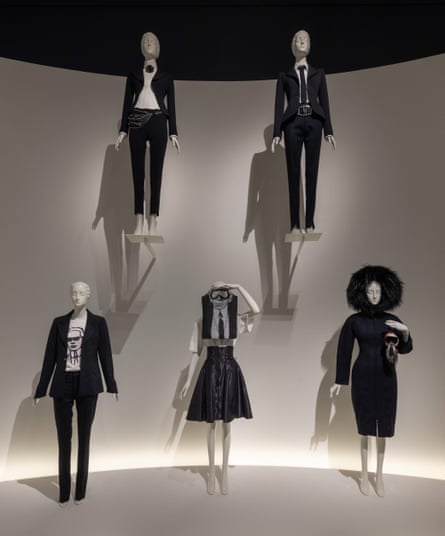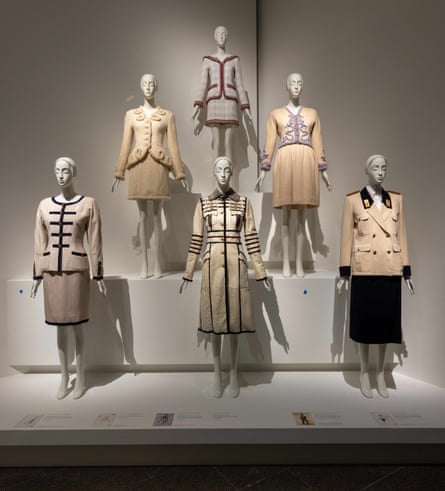
Deep in the bowels of the Metropolitan Museum of Art’s new Karl Lagerfeld exhibition is a small circular room housing an installation of 81 iPhones.
Each screen flashes with footage of Lagerfeld in 2011, giggling and stamping his foot at the peak of his powdered-wig pomp, and a series of “Karlisms” – including his famous declaration that sweatpants are “a sign of defeat”. There are also lesser-known phrases, such as: “I always say what I think, and sometimes even what I don’t think”, a remark that feels pertinent to debates that have swirled in the run-up to the show about whether the New York institution was wise to celebrate the designer in the first place.
Karl Lagerfeld: A Line of Beauty, which opens on Friday, walks a difficult line. Its entire purpose is to venerate the designer, who died in 2019 at the age of 85 after a spectacular 65-year career, whose legacy has recently been reappraised owing to much-documented fatphobic and Islamaphobic comments he made in the early 2000s.
The exhibition tackles this by largely focusing on Lagerfeld’s work, and particularly his aptitude for sketching. It opens with a huge video wall displaying a close crop of his fingerless-gloved hand-sketching gowns. Next to that is a recreation of his desk – an incredible mess of art books, sketch pads, sketches and sharpie pens, complete with a glass of red wine – an installation which speaks of a creative genius overflowing with ideas.
There are sketches displayed next to many of the 200 outfits on show, which are grouped by theme, taking in his time at Fendi, from 1965 to 1990, Chloé, where he worked in the 1970s and again in the 1990s, and Chanel (1982 to 2019), as well as the eponymous label he launched in 1984. These rooms, said curator Andrew Bolton, tackle Lagerfeld’s “duality” by examining contradictory themes such as “feminine/masculine” “romantic/military” “historical/futuristic” “canonical/countercultural”. In this way, Bolton said he tried to address the controversy about Lagerfeld “subliminally – through the clothes. Because I think that we all have dualities, things we’re not proud of in our lives. When you walk through the show, I want to show those contradictions more indirectly.”

In a set designed by architect Tadao Ando, the gowns are presented at contrasting levels in each sleek room, with displays including a bouclé suit paired with a monochrome robot headset – illustrating Lagerfeld’s modernisation of the house of Chanel – and dozens of incredibly intricate wedding gowns, with trompe l’oeil flowers. There are also witty, surrealist pieces including a 1980s silk crepe dress from his eponymous line embroidered with huge gold candlesticks.
after newsletter promotion

The final room tackles Lagerfeld the man, displaying what the show argues was his “greatest deception” – his self-presentation – via his famous fan, sunglasses, and fingerless gloves displayed in Perspex boxes like relics. It is not until the end of the show that you see the man himself, which was intentional, said Bolton, who believes Lagerfeld’s design work is more intimate than his persona. “ I wanted the rawness of Karl, before you get to ‘the puppet’ or ‘dolly’ that he called himself.”
“He said things that were very funny, things that were very poignant but also things that were very offensive and obviously we don’t condone them so I didn’t want to put any of those in. But I do want to get people to get an indication of his wit,” said Bolton of the iPads. The show, he adds, “is very much about his work more than him – but I don’t believe you can separate the man from the designer”.



